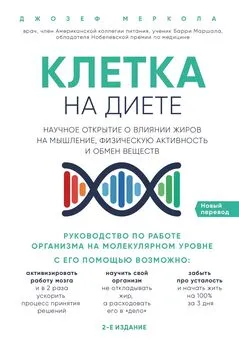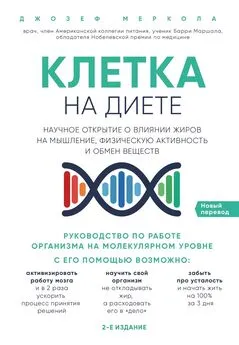Джозеф Меркола - Кето-навигатор
- Название:Кето-навигатор
- Автор:
- Жанр:
- Издательство:Литагент 5 редакция «БОМБОРА»
- Год:2019
- Город:Москва
- ISBN:978-5-04-100005-9
- Рейтинг:
- Избранное:Добавить в избранное
-
Отзывы:
-
Ваша оценка:
Джозеф Меркола - Кето-навигатор краткое содержание
Кето-навигатор - читать онлайн бесплатно ознакомительный отрывок
Интервал:
Закладка:
10. Morris DH. Metabolism of alpha-linolenic acid. Flax Council of Canada . 2014.
11. Barcelo-Coblijn G, Murphy EJ. Alpha-linolenic acid and its conversion to longer chain n-3 fatty acids: benefits for human health and a role in maintaining tissue n-3 fatty acid levels. Prog Lipid Res . 2009 Nov; 48 (6): 355–374.
12. Al MD, Badart-Smook A, von Houwelingen AC, et al. Fat intake of women during normal pregnancy: relationship with maternal and neonatal essential fatty acid status. J Am Coll Nutr . 1996; 15 (1): 49–55.
13. Carlson SE, Werkman SH, Peeples JM, et al. Long-chain fatty acids and early visual and cognitive development of preterm infants. Eur J Clin Nutr . 1994 Aug; 48 Suppl 2: S27–30.
14. Hornstra G. Essential fatty acids in mothers and their neonates. Am J Clin Nutr . 2000 May; 71 (5 Suppl): 1262s–1269s.
15. Burdge GC, Wootton SA. Conversion of alpha-linolenic acid to eicosapentaenoic, docosapentaenoic and docosahexaenoic acids in young women. Br J Nutr . 2002 Oct; 88: 411–420.
16. Docosahexaenoic acid (DHA). Monograph. Altern Med Rev . 2009; 14 (4): 391–399.
17. Hornstra G. Essential fatty acids in mothers and their neonates. Am J Clin Nutr . 2000 May; 71 (5 Suppl): 1262s–1269s.
18. Barcelo-Coblijn G, Murphy EJ. Alpha-linolenic acid and its conversion to longer chain n-3 fatty acids: benefits for human health and a role in maintaining tissue n-3 fatty acid levels. Prog Lipid Res . 2009 Nov; 48 (6): 355–374.
19. Там же.
20. Gibson RA, Neumann MA, Makrides M. Effect of increasing breast milk docosahexaenoic acid on plasma and erythrocyte phospholipid fatty acids and neural indices of exclusively breast fed infants. Eur J Clin Nutr . 1997 Sep; 51 (9): 578–584.
21. Hornstra G. Essential fatty acids in mothers and their neonates. Am J Clin Nutr . 2000 May; 71 (5 Suppl): 1262s–1269s.
22. Barcelo-Coblijn G, Murphy EJ. Alpha-linolenic acid and its conversion to longer chain n-3 fatty acids: benefits for human health and a role in maintaining tissue n-3 fatty acid levels. Prog Lipid Res . 2009 Nov; 48 (6): 355–374.
23. Youdim KA, Martin A, Joseph JA. Essential fatty acids and the brain: possible health implications. Int J Dev Neurosci . 2000 Jul-Aug; 18 (4–5): 383–399.
24. Willatts P, Forsyth JS, DiModugno MK, et al. Effect of long-chain polyunsaturated fatty acids in infant formula on problem solving at 10 months of age. Lancet. 1998 Aug 29; 352 (9129): 688–691.
25. Youdim KA, Martin A, Joseph JA. Essential fatty acids and the brain: possible health implications. Int J Dev Neurosci . 2000 Jul-Aug; 18 (4–5): 383–399.
26. Barcelo-Coblijn G, Murphy EJ. Alpha-linolenic acid and its conversion to longer chain n-3 fatty acids: benefits for human health and a role in maintaining tissue n-3 fatty acid levels. Prog Lipid Res . 2009 Nov; 48 (6): 355–374.
27. Lucas A, Morley R, Cole TJ, et al. Breast milk and subsequent intelligence quotient in children born preterm. Lancet. 1992 Feb 1; 339 (8788): 261–264.
28. Rodgers B. Feeding in infancy and later ability and attainment: a longitudinal study. Dev Med Child Neurol . 1978 Aug; 20 (4): 421–426.
29. Taylor B, Wadsworth J. Breast feeding and child development at five years. Dev Med Child Neurol . 1984 Feb; 26 (1): 73–80.
30. Rogan WJ, Gladen BC. Breast-feeding and cognitive development. Early Hum Dev . 1993 Jan; 31 (3): 181–193.
31. Horwood LJ, Fergusson DM. Breastfeeding and later cognitive and academic outcomes. Pediatrics. 1998 Jan; 101 (1): E9.
32. Lanting CI, Fidler V, Huisman M, et al. Neurological differences between 9-yearold children fed breast-milk or formula-milk as babies. Lancet. 1994 Nov 12; 344 (8933): 1319–1322.
33. Menkes JH. Early feeding history of children with learning disorders. Dev Med Child Neurol . 1977 Apr; 19 (2): 169–171.
34. Rodgers B. Feeding in infancy and later ability and attainment: a longitudinal study. Dev Med Child Neurol . 1978 Aug; 20 (4): 421–426.
35. Taylor B, Wadsworth J. Breast feeding and child development at five years. Dev Med Child Neurol . 1984 Feb; 26 (1): 73–80.
36. Hornstra G. Essential fatty acids in mothers and their neonates. Am J Clin Nutr . 2000 May; 71(5 Suppl): 1262s–1269s.
37. Popeski D, Ebbeling LR, Brown PB, et al. Blood pressure during pregnancy in Canadian Inuit: community differences related to diet. CMAJ . 1991 Sep 1; 145 (5): 445–454.
38. Williams MA, Zingheim RW, King IB, et al. Omega-3 fatty acids in maternal erythrocytes and risk of preeclampsia. Epidemiology. 1995 May; 6 (3): 232–237.
39. Там же.
40. Onwude JL, Lilford RJ, Hjartardottir H, et al. A randomised double blind placebo controlled trial of fish oil in high risk pregnancy. Br J Obstet Gynaecol . 1995 Feb; 102 (2): 95–100.
41. Logan AC. Neurobehavioral aspects of omega-3 fatty acids: possible mechanisms and therapeutic value in major depression. Altern Med Rev . 2003 Nov; 8 (4): 410–425.
42. Klerman GL, Weissman MM. Increasing rates of depression. JAMA .1989 Apr 21; 261 (15): 2229–2235.
43. Kornstein SG, Schneider RK. Clinical features of treatment-resistant depression. J Clin Psychiatry . 2001; 62 Suppl 16: 18–25.
44. Lin PY, Huang SY, Su KP. A meta-analytic review of polyunsaturated fatty acid compositions in patients with depression. Biol Psychiatry . 2010 Jul 15; 68 (2): 140–147.
45. Tanskanen A, Hibbeln JR, Tuomilehto J, et al. Fish consumption and depressive symptoms in the general population in Finland. Psychiatr Serv . 2001 Apr; 52 (4): 529–531.
46. Maes M, Smith RS. Fatty acids, cytokines, and major depression. Biol Psychiatry . 1998 Mar 1; 43 (5): 313–314.
47. Там же.
48. Mazereeuw G, Lanctot KL, Chau SA, et al. Effects of omega-3 fatty acids on cognitive performance: a meta-analysis. Neurobiol Aging . 2012 Jul; 33(7): 1482.e17–29.
49. Xia Z, DePierre JW, Nassberger L. Tricyclic antidepressants inhibit IL-6, IL-1 beta and TNF-alpha release in human blood monocytes and IL-2 and interferongamma in T cells. Immunopharmacology. 1996 Aug; 34 (1): 27–37.
50. Serhan CN, Arita M, Hong S, et al. Resolvins, docosatrienes, and neuroprotectins, novel omega-3-derived mediators, and their endogenous aspirin-triggered epimers. Lipids. 2004 Nov; 39 (11): 1125–1132.
51. Hibbeln JR. Fish consumption and major depression. Lancet. 1998 Apr 18; 351 (9110): 1213.
52. Hibbeln JR, Gow RV. The potential for military diets to reduce depression, suicide, and impulsive aggression: a review of current evidence for omega-3 and omega-6 fatty acids. Mil Med . 2014 Nov; 17911 Suppl): 117–128.
53. Tanskanen A, Hibbeln JR, Tuomilehto J, et al. Fish consumption and depressive symptoms in the general population in Finland. Psychiatr Serv . 2001 Apr; 52 (4): 529–531.
54. Silvers KM, Scott KM. Fish consumption and self-reported physical and mental health status. Public Health Nutr . 2002 Jun; 5 (3): 427–431.
55. Adams PB, Lawson S, Sanigorski A, et al. Arachidonic acid to eicosapentaenoic acid ratio in blood correlates positively with clinical symptoms of depression. Lipids. 1996 Mar; 31 Suppl: S157–161.
56. Tiemeier H, van Tuijl HR, Hofman A, et al. Plasma fatty acid composition and depression are associated in the elderly: the Rotterdam Study. Am J Clin Nutr . 2003 Jul; 78 (1): 40–46.
57. Mamalakis G, Tornaritis M, Kafatos A. Depression and adipose essential polyunsaturated fatty acids. Prostaglandins Leukot Essent Fatty Acids . 2002 Nov; 67 (5): 311–318.
58. Hibbeln JR. Seafood consumption, the DHA content of mothers’ milk and prevalence rates of postpartum depression: a cross-national, ecological analysis. J Affect Disord . 2002 May; 69 (1–3): 15–29.
59. Mazereeuw G, Lanctot KL, Chau SA, et al. Effects of omega-3 fatty acids on cognitive performance: a meta-analysis. Neurobiol Aging . 2012 Jul; 33 (7): 1482.e17–29.
60. Там же.
61. Там же.
62. Nemets B, Stahl Z, Belmaker RH. Addition of omega-3 fatty acid to maintenance medication treatment for recurrent unipolar depressive disorder. Am J Psychiatry . 2002 Mar; 159 (3): 477–479.
63. Su KP, Huang SY, Chiu CC, et al. Omega-3 fatty acids in major depressive disorder. A preliminary double-blind, placebo-controlled trial. Eur Neuropsychopharmacol . 2003 Aug; 13 (4): 267–271.
64. Lin PY, Huang SY, Su KP. A meta-analytic review of polyunsaturated fatty acid compositions in patients with depression. Biol Psychiatry . 2010 Jul 15; 68 (2): 140–147.
65. Grosso G, Pajak A, Marventano S, et al. Role of omega-3 fatty acids in the treatment of depressive disorders: a comprehensive meta-analysis of randomized clinical trials. PLoS One . 2014; 9 (5): e96905.
66. Nemets B, Stahl Z, Belmaker RH. Addition of omega-3 fatty acid to maintenance medication treatment for recurrent unipolar depressive disorder. Am J Psychiatry . 2002 Mar; 159 (3): 477–479.
67. Peet M, Horrobin DF. A dose-ranging study of the effects of ethyleicosapentaenoate in patients with ongoing depression despite apparently adequate treatment with standard drugs. Arch Gen Psychiatry . 2002 Oct; 59 (1): 913–919.
68. Frangou S, Lewis M, McCrone P. Efficacy of ethyl-eicosapentaenoic acid in bipolar depression: randomised double-blind placebo-controlled study. Br J Psychiatry . 2006 Jan; 188: 46–50.
69. Nemets H, Nemets B, Apter A, et al. Omega-3 treatment of childhood depression: a controlled, double-blind pilot study. Am J Psychiatry . 2006 Jun; 163 (6): 1098–1100.
70. Su KP, Huang SY, Chiu TH, et al. Omega-3 fatty acids for major depressive disorder during pregnancy: results from a randomized, double-blind, placebocontrolled trial. J Clin Psychiatry . 2008 Apr; 69 (4): 644–651.
71. Jazayeri S, Tehrani-Doost M, Keshavarz SA, et al. Comparison of therapeutic effects of omega-3 fatty acid eicosapentaenoic acid and fluoxetine, separately and in combination, in major depressive disorder. Aust N Z J Psychiatry . 2008 Mar; 42 (3): 192–198.
72. Jadoon A, Chiu CC, McDermott L, et al. Associations of polyunsaturated fatty acids with residual depression or anxiety in older people with major depression. J Affect Disord . 2012 Feb; 136 (3): 918–925.
73. Wolfe AR, Ogbonna EM, Lim S, et al. Dietary linoleic and oleic fatty acids in relation to severe depressed mood: 10 years follow-up of a national cohort. Prog Neuropsychopharmacol Biol Psychiatry . 2009 Aug 31; 33 (6): 972–977.
74. Lucas M, Mirzaei F, O’Reilly EJ, et al. Dietary intake of n-3 and n-6 fatty acids and the risk of clinical depression in women: a 10-y prospective follow-up study. Am J Clin Nutr . 2011 Jun; 93 (6): 1337–1343.
75. Kidd PM. Omega-3 DHA and EPA for cognition, behavior, and mood: clinical findings and structural-functional synergies with cell membrane phospholipids. Altern Med Rev . 2007 Sep; 12 (3): 207–227.
76. Там же.
77. Hirayama S, Hamazaki T, Terasawa K. Effect of docosahexaenoic acid-containing food administration on symptoms of attention-deficit/hyperactivity disorder – a placebo-controlled double-blind study. Eur J Clin Nutr . 2004 Mar; 58 (3): 467–473.
78. Stevens L, Zhang W, Peck L, et al. EFA supplementation in children with inattention, hyperactivity, and other disruptive behaviors. Lipids. 2003 Oct; 38 (1): 1007–1021.
Читать дальшеИнтервал:
Закладка:










